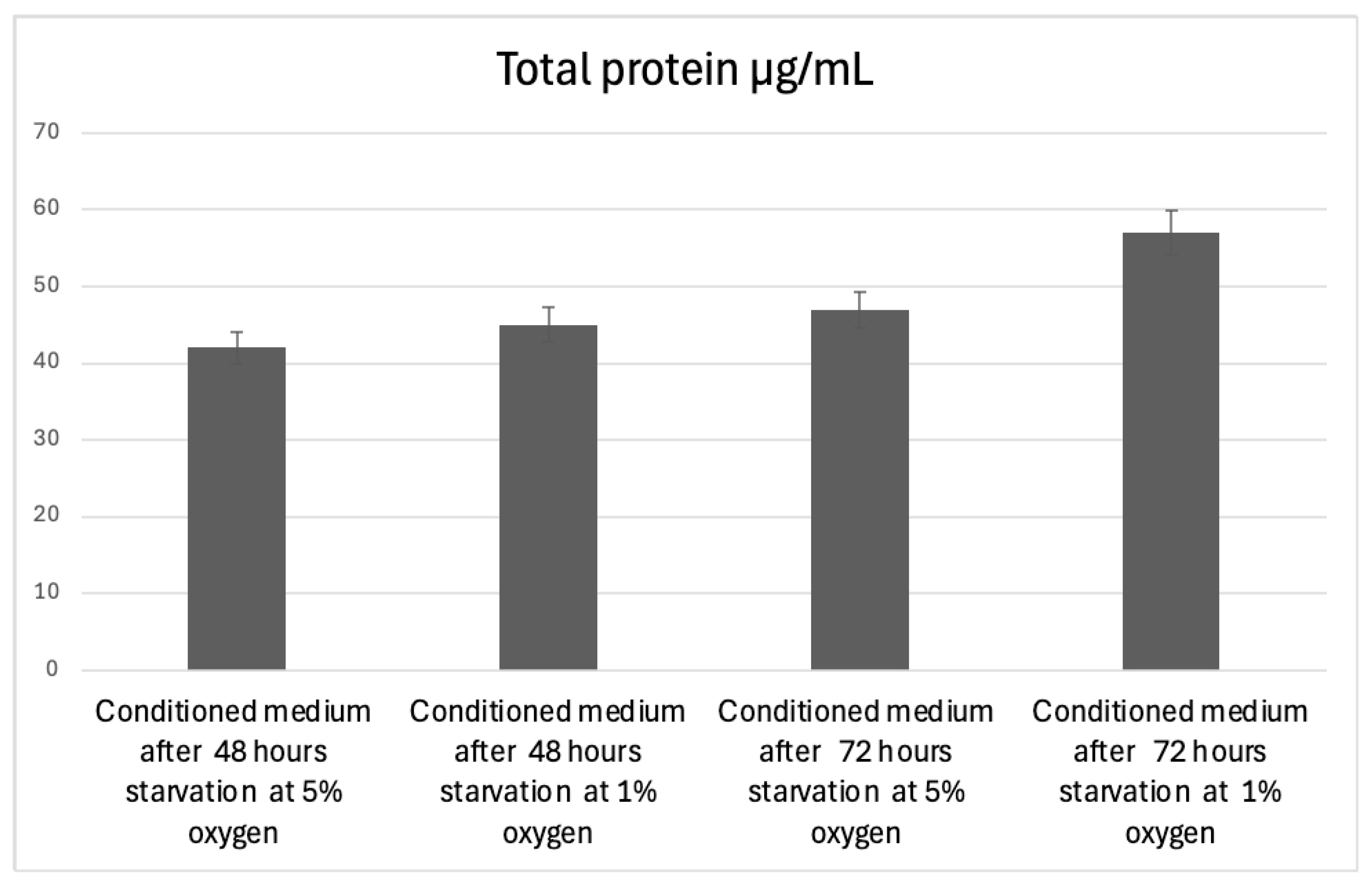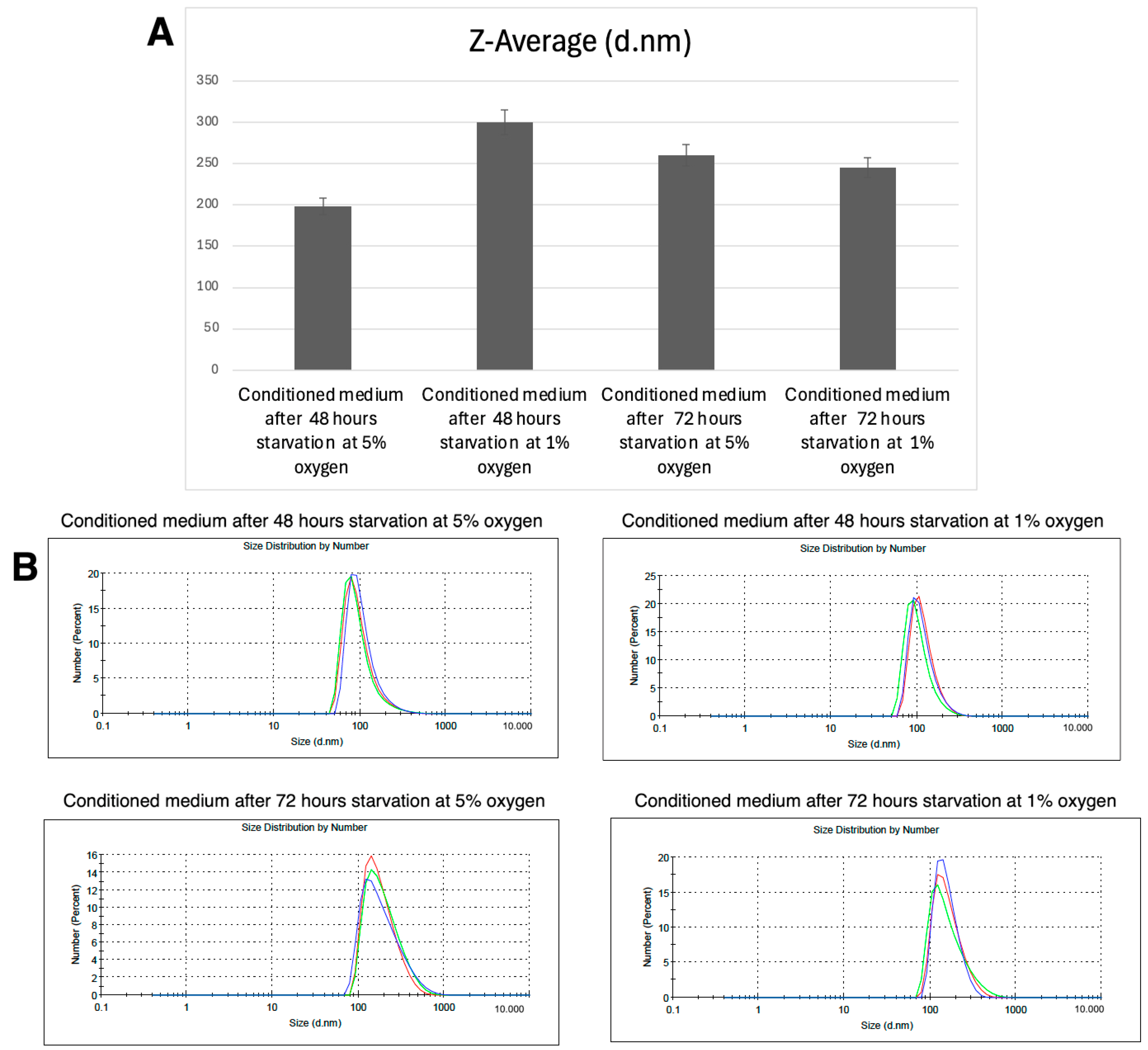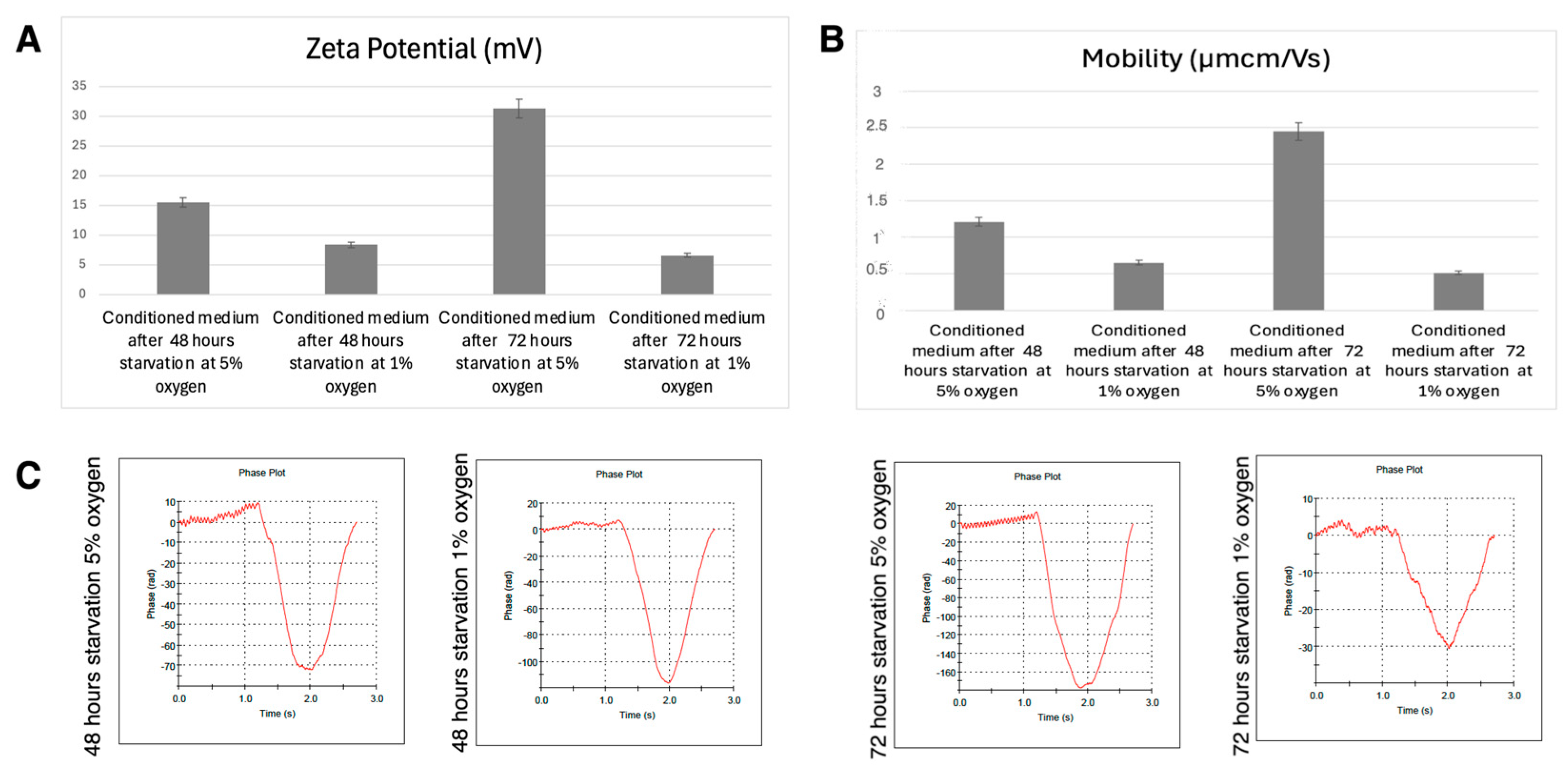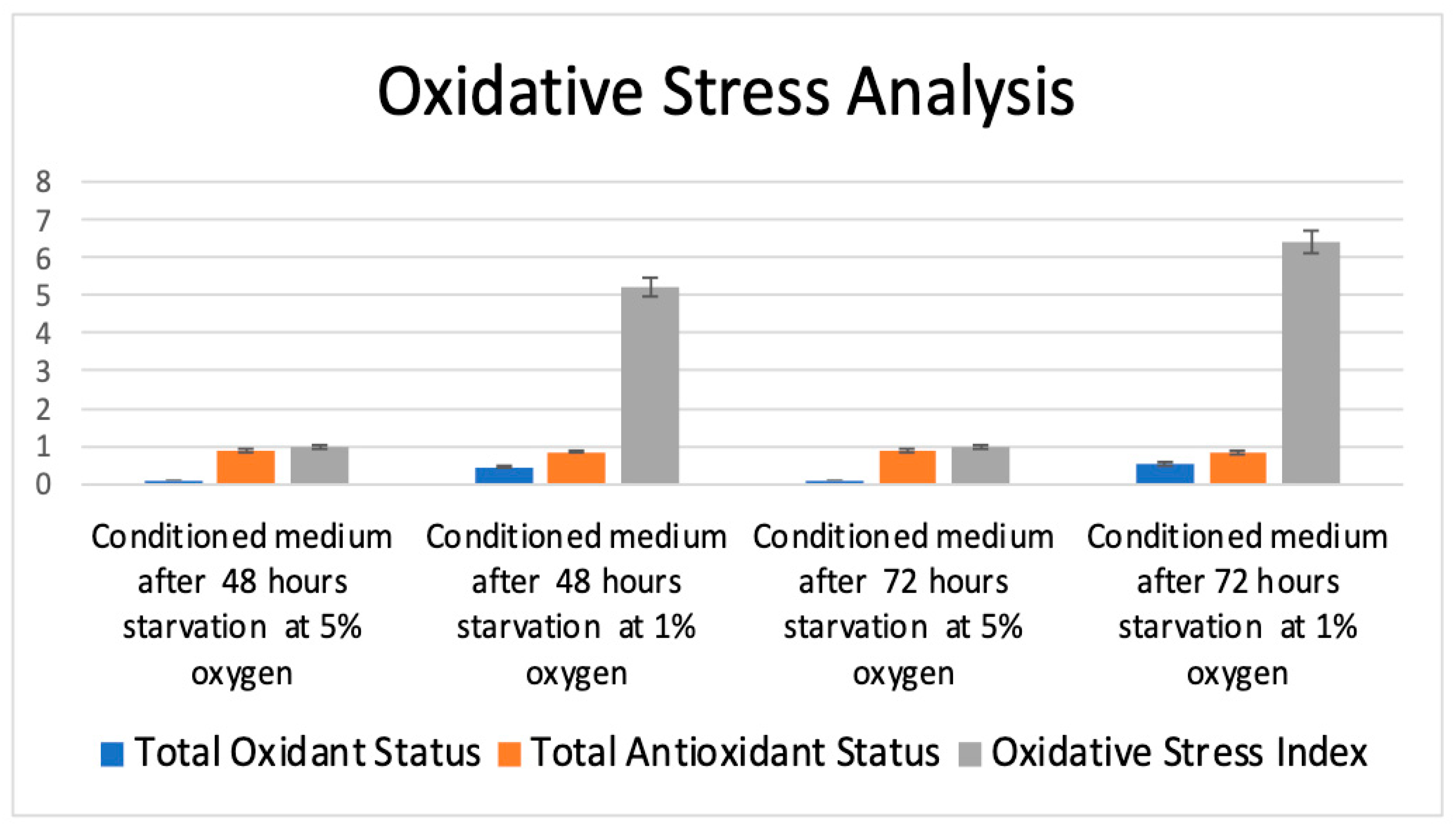Physicochemical and Biological Modifications in Mesenchymal Stem Cells-Derived Conditioned Media Under Hypoxic Preconditioning: Impact on Oxidative Stress and Nanoparticle Stability
Abstract
:1. Introduction
2. Materials and Methods
2.1. Cell Culture and Hypoxic Preconditioning
2.1.1. Isolation and Expansion of Wharton’s Jelly-Derived Mesenchymal Stem Cells (WJ-MSCs)
2.1.2. Hypoxic Preconditioning and Conditioned Medium Collection
2.2. Cell Lysate Preparation
2.3. Metabolic Activity and Mitochondrial Analysis
2.3.1. MTT Assay for Cell Viability
2.3.2. MitoTracker Staining for Mitochondrial Activity
2.4. Hypoxia-Related Protein Analysis ELISA for HIF-1α Expression
2.5. Conditioned Media Collection and Nanoparticle Analysis
2.5.1. Starvation and Conditioned Media Collection
2.5.2. Nanoparticle Size and Zeta Potential Analysis
2.5.3. Total Protein Quantification
2.6. Oxidative Stress Analysis
2.6.1. Total Oxidant Status (TOS) Measurement
2.6.2. Total Antioxidant Status (TAS) Measurement
2.6.3. Oxidative Stress Index (OSI) Calculation
2.7. Statistical Analysis
3. Results
3.1. MTT Analysis Results
3.2. Mitotracker Staining
3.3. Hypoxia Inducible Factor (HIF) 1 Alpha Elisa Results
3.4. Conditioned Media Tests
3.4.1. Total Protein Elisa Results
3.4.2. DLS Results
3.4.3. Zeta Potential Results
3.4.4. Mobility Results
3.5. Oxidative Stress Analysis Results
3.5.1. Total Antioxidant Status (TAS) Results
3.5.2. Total Oxidant Status (TOS) Results
3.5.3. Oxidative Stress Index
4. Discussion
5. Conclusions
Author Contributions
Funding
Institutional Review Board Statement
Informed Consent Statement
Data Availability Statement
Conflicts of Interest
References
- Gupta, S.; Rawat, S.; Krishnakumar, V.; Rao, E.P.; Mohanty, S. Hypoxia Preconditioning Elicit Differential Response in Tissue-Specific MSCs via Immunomodulation and Exosomal Secretion. Cell Tissue Res. 2022, 388, 535–548. [Google Scholar] [CrossRef] [PubMed]
- Pulido-Escribano, V.; Torrecillas-Baena, B.; Camacho-Cardenosa, M.; Dorado, G.; Gálvez-Moreno, M.Á.; Casado-Díaz, A. Role of Hypoxia Preconditioning in Therapeutic Potential of Mesenchymal Stem-Cell-Derived Extracellular Vesicles. World J. Stem Cells 2022, 14, 453. [Google Scholar] [CrossRef]
- Mahjoor, M.; Fakouri, A.; Farokhi, S.; Nazari, H.; Afkhami, H.; Heidari, F. Regenerative Potential of Mesenchymal Stromal Cells in Wound Healing: Unveiling the Influence of Normoxic and Hypoxic Environments. Front. Cell Dev. Biol. 2023, 11, 1245872. [Google Scholar] [CrossRef] [PubMed]
- Andreeva, E.R.; Buravkova, L.B. Paracrine Activity of Multipotent Mesenchymal Stromal Cells and Its Modulation in Hypoxia. Hum. Physiol. 2013, 39, 315–322. [Google Scholar] [CrossRef]
- Palomäki, S.; Pietilä, M.; Laitinen, S.; Pesälä, J.; Sormunen, R.; Lehenkari, P.; Koivunen, P. HIF-1α Is Upregulated in Human Mesenchymal Stem Cells. Stem Cells 2013, 31, 1902–1909. [Google Scholar] [CrossRef] [PubMed]
- Hervouet, E.; Cízková, A.; Demont, J.; Vojtísková, A.; Pecina, P.; Franssen-van Hal, N.L.W.; Keijer, J.; Simonnet, H.; Ivének, R.; Kmoch, S.; et al. HIF and Reactive Oxygen Species Regulate Oxidative Phosphorylation in Cancer. Carcinogenesis 2008, 29, 1528–1537. [Google Scholar] [CrossRef]
- Chang, Y.H.; Vuong, C.K.; Ngo, N.H.; Yamashita, T.; Ye, X.; Futamura, Y.; Fukushige, M.; Obata-Yasuoka, M.; Hamada, H.; Osaka, M.; et al. Extracellular Vesicles Derived from Wharton’s Jelly Mesenchymal Stem Cells Inhibit the Tumor Environment via the MiR-125b/HIF1α Signaling Pathway. Sci. Rep. 2022, 12, 1–16. [Google Scholar] [CrossRef]
- Bodart-Santos, V.; De Carvalho, L.R.P.; De Godoy, M.A.; Batista, A.F.; Saraiva, L.M.; Lima, L.G.; Abreu, C.A.; De Felice, F.G.; Galina, A.; Mendez-Otero, R.; et al. Extracellular Vesicles Derived from Human Wharton’s Jelly Mesenchymal Stem Cells Protect Hippocampal Neurons from Oxidative Stress and Synapse Damage Induced by Amyloid-β Oligomers. Stem Cell Res. Ther. 2019, 10, 1–13. [Google Scholar] [CrossRef]
- Peshkova, M.; Korneev, A.; Suleimanov, S.; Vlasova, I.I.; Svistunov, A.; Kosheleva, N.; Timashev, P. MSCs’ Conditioned Media Cytokine and Growth Factor Profiles and Their Impact on Macrophage Polarization. Stem Cell Res. Ther. 2023, 14, 1–15. [Google Scholar] [CrossRef]
- Smolinská, V.; Boháč, M.; Danišovič, Ľ. Current Status of the Applications of Conditioned Media Derived from Mesenchymal Stem Cells for Regenerative Medicine. Physiol. Res. 2023, 72, S233. [Google Scholar] [CrossRef]
- Xu, Y.F.; Wu, Y.X.; Wang, H.M.; Gao, C.H.; Xu, Y.Y.; Yan, Y. Bone Marrow-Derived Mesenchymal Stem Cell-Conditioned Medium Ameliorates Diabetic Foot Ulcers in Rats. Clinics 2023, 78. [Google Scholar] [CrossRef] [PubMed]
- Nabavizadeh, S.S.; Talaei-Khozani, T.; Zarei, M.; Zare, S.; Hosseinabadi, O.K.; Tanideh, N.; Daneshi, S. Attenuation of Osteoarthritis Progression through Intra-Articular Injection of a Combination of Synovial Membrane-Derived MSCs (SMMSCs), Platelet-Rich Plasma (PRP) and Conditioned Medium (Secretome). J. Orthop. Surg. Res. 2022, 17, 102. [Google Scholar] [CrossRef] [PubMed]
- Quan, J.; Liu, Q.; Li, P.; Yang, Z.; Zhang, Y.; Zhao, F.; Zhu, G. Mesenchymal Stem Cell Exosome Therapy: Current Research Status in the Treatment of Neurodegenerative Diseases and the Possibility of Reversing Normal Brain Aging. Stem Cell Res. Ther. 2025, 16, 76. [Google Scholar] [CrossRef] [PubMed]
- Tan, F.; Li, X.; Wang, Z.; Li, J.; Shahzad, K.; Zheng, J. Clinical Applications of Stem Cell-Derived Exosomes. Signal Transduct. Target. Ther. 2024, 9, 17. [Google Scholar] [CrossRef]
- Zhang, X.; Kuang, Q.; Xu, J.; Lin, Q.; Chi, H.; Yu, D. MSC-Based Cell Therapy in Neurological Diseases: A Concise Review of the Literature in Pre-Clinical and Clinical Research. Biomolecules 2024, 14, 538. [Google Scholar] [CrossRef]
- Razban, V.; Lotfi, A.S.; Soleimani, M.; Ahmadi, H.; Massumi, M.; Khajeh, S.; Ghaedi, M.; Arjmand, S.; Najavand, S.; Khoshdel, A. HIF-1α Overexpression Induces Angiogenesis in Mesenchymal Stem Cells. Biores Open Access 2012, 1, 174. [Google Scholar] [CrossRef]
- Zhang, D.; Lv, F.L.; Wang, G.H. Effects of HIF-1α on Diabetic Retinopathy Angiogenesis and VEGF Expression. Eur. Rev. Med. Pharmacol. Sci. 2018, 22, 5071–5076. [Google Scholar] [CrossRef]
- Xiang, Y.; Yao, X.; Wang, X.; Zhao, H.; Zou, H.; Wang, L.; Zhang, Q.X. Houshiheisan Promotes Angiogenesis via HIF-1α/VEGF and SDF-1/CXCR4 Pathways: In Vivo and İn Vitro. Biosci. Rep. 2019, 39, BSR20191006. [Google Scholar] [CrossRef]
- Bister, N.; Pistono, C.; Huremagic, B.; Jolkkonen, J.; Giugno, R.; Malm, T. Hypoxia and Extracellular Vesicles: A Review on Methods, Vesicular Cargo and Functions. J. Extracell. Vesicles 2020, 10, e12002. [Google Scholar] [CrossRef]
- Joo, H.S.; Suh, J.H.; Lee, H.J.; Bang, E.S.; Lee, J.M. Current Knowledge and Future Perspectives on Mesenchymal Stem Cell-Derived Exosomes as a New Therapeutic Agent. Int. J. Mol. Sci. 2020, 21, 727. [Google Scholar] [CrossRef]
- Mao, C.Y.; Zhang, T.T.; Li, D.J.; Zhou, E.; Fan, Y.Q.; He, Q.; Wang, C.Q.; Zhang, J.F. Extracellular Vesicles from Hypoxia-Preconditioned Mesenchymal Stem Cells Alleviates Myocardial Injury by Targeting Thioredoxin-Interacting Protein-Mediated Hypoxia-Inducible Factor-1α Pathway. World J. Stem Cells 2022, 14, 183. [Google Scholar] [CrossRef] [PubMed]
- Patton, M.C.; Zubair, H.; Khan, M.A.; Singh, S.; Singh, A.P. Hypoxia Alters the Release and Size Distribution of Extracellular Vesicles in Pancreatic Cancer Cells to Support Their Adaptive Survival. J. Cell Biochem. 2019, 121, 828. [Google Scholar] [CrossRef]
- Midekessa, G.; Godakumara, K.; Ord, J.; Viil, J.; Lättekivi, F.; Dissanayake, K.; Kopanchuk, S.; Rinken, A.; Andronowska, A.; Bhattacharjee, S.; et al. Zeta Potential of Extracellular Vesicles: Toward Understanding the Attributes That Determine Colloidal Stability. ACS Omega 2020, 5, 16701–16710. [Google Scholar] [CrossRef]
- Sabra, M.; Sabe, S.A.; Harris, D.D.; Xu, C.M.; Broadwin, M.; Bellam, K.G.; Banerjee, D.; Abid, M.R.; Sellke, F.W. Ischemic Myocardial Inflammatory Signaling in Starvation versus Hypoxia-Derived Extracellular Vesicles: A Comparative Analysis. JTCVS Open 2023, 16, 419–428. [Google Scholar] [CrossRef] [PubMed]
- Akagi, S.; Nakamura, K.; Kondo, M.; Hirohata, S.; Udono, H.; Nishida, M.; Saito, Y.; Yoshida, M.; Miyoshi, T.; Ito, H. Evidence for Hypoxia-Induced Shift in ATP Production from Glycolysis to Mitochondrial Respiration in Pulmonary Artery Smooth Muscle Cells in Pulmonary Arterial Hypertension. J. Clin. Med. 2023, 12, 5028. [Google Scholar] [CrossRef]
- Lin, D.; Yan, K.; Chen, L.; Chen, J.; Xu, J.; Xie, Z.; Li, Z.; Lin, S.; Li, J.; Chen, Z. Hypoxia-Induced Reprogramming of Glucose-Dependent Metabolic Pathways Maintains the Stemness of Human Bone Marrow-Derived Endothelial Progenitor Cells. Sci. Rep. 2023, 13, 8776. [Google Scholar] [CrossRef]
- Kumar, S.; Verma, R.; Tyagi, N.; Gangenahalli, G.; Verma, Y.K. Therapeutics Effect of Mesenchymal Stromal Cells in Reactive Oxygen Species-Induced Damages. Human Cell 2021, 35, 37–50. [Google Scholar] [CrossRef]
- Chen, Y.; Liang, Y.; Luo, X.; Hu, Q. Oxidative Resistance of Leukemic Stem Cells and Oxidative Damage to Hematopoietic Stem Cells under Pro-Oxidative Therapy. Cell Death Dis. 2020, 11, 291. [Google Scholar] [CrossRef] [PubMed]
- Han, Y.; Yang, J.; Fang, J.; Zhou, Y.; Candi, E.; Wang, J.; Hua, D.; Shao, C.; Shi, Y. The Secretion Profile of Mesenchymal Stem Cells and Potential Applications in Treating Human Diseases. Signal Transduct. Target. Ther. 2022, 7, 92. [Google Scholar] [CrossRef]
- Han, Y.; Chen, Q.; Zhang, L.; Dissanayaka, W.L. Indispensable Role of HIF-1α Signaling in Post-Implantation Survival and Angio-/Vasculogenic Properties of SHED. Front. Cell Dev. Biol. 2021, 9, 655073. [Google Scholar] [CrossRef]
- Mas-Bargues, C.; Sanz-Ros, J.; Román-Domínguez, A.; Inglés, M.; Gimeno-Mallench, L.; El Alami, M.; Viña-Almunia, J.; Gambini, J.; Viña, J.; Borrás, C. Relevance of Oxygen Concentration in Stem Cell Culture for Regenerative Medicine. Int. J. Mol. Sci. 2019, 20, 1195. [Google Scholar] [CrossRef] [PubMed]
- Lin, H.D.; Fong, C.Y.; Biswas, A.; Bongso, A. Hypoxic Wharton’s Jelly Stem Cell Conditioned Medium Induces Immunogenic Cell Death in Lymphoma Cells. Stem Cells Int. 2020, 2020, 4670948. [Google Scholar] [CrossRef] [PubMed]






Disclaimer/Publisher’s Note: The statements, opinions and data contained in all publications are solely those of the individual author(s) and contributor(s) and not of MDPI and/or the editor(s). MDPI and/or the editor(s) disclaim responsibility for any injury to people or property resulting from any ideas, methods, instructions or products referred to in the content. |
© 2025 by the authors. Licensee MDPI, Basel, Switzerland. This article is an open access article distributed under the terms and conditions of the Creative Commons Attribution (CC BY) license (https://creativecommons.org/licenses/by/4.0/).
Share and Cite
Çiçek, G.; Bağcı, F.Ö.; Filizfidan, M.; Duman, S.; Aktan, T.M. Physicochemical and Biological Modifications in Mesenchymal Stem Cells-Derived Conditioned Media Under Hypoxic Preconditioning: Impact on Oxidative Stress and Nanoparticle Stability. Life 2025, 15, 702. https://doi.org/10.3390/life15050702
Çiçek G, Bağcı FÖ, Filizfidan M, Duman S, Aktan TM. Physicochemical and Biological Modifications in Mesenchymal Stem Cells-Derived Conditioned Media Under Hypoxic Preconditioning: Impact on Oxidative Stress and Nanoparticle Stability. Life. 2025; 15(5):702. https://doi.org/10.3390/life15050702
Chicago/Turabian StyleÇiçek, Gülsemin, Fatma Öz Bağcı, Mehmet Filizfidan, Selçuk Duman, and Tahsin Murad Aktan. 2025. "Physicochemical and Biological Modifications in Mesenchymal Stem Cells-Derived Conditioned Media Under Hypoxic Preconditioning: Impact on Oxidative Stress and Nanoparticle Stability" Life 15, no. 5: 702. https://doi.org/10.3390/life15050702
APA StyleÇiçek, G., Bağcı, F. Ö., Filizfidan, M., Duman, S., & Aktan, T. M. (2025). Physicochemical and Biological Modifications in Mesenchymal Stem Cells-Derived Conditioned Media Under Hypoxic Preconditioning: Impact on Oxidative Stress and Nanoparticle Stability. Life, 15(5), 702. https://doi.org/10.3390/life15050702





